*When we try anything new it can be hard. In the early days we might need to turn to props, mnemonics, guidebooks or top tips to help us get to grips with even the basics. If someone acts as a coach and we get time to practice then our confidence grows. We turn to the props and guides less and less. One day we realise we can just ‘do’ it…the thing…whatever it is…without thinking!
I’ve always thought this diagram summed this journey up brilliantly.
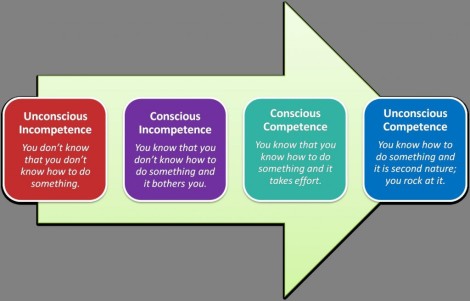
My daughter Lydia is learning to drive. I think she’s probably moving from the purple square to the green one at the moment. I keep finding her ‘Driving Skills Workbook’ lying around and she’s having lots of driving lessons. I thought I remembered a scene in the 70s sitcom ‘Man About The House’ about learning to drive using props to help. It took a while but here it is…..and remember it was broadcast in 1975.
When it comes to getting to grips with ABCD – asset based community development – it can feel just as mysterious as driving a car does to the average 17 year old. Even the language feels unfamiliar and awkward at first. I’d like to think of an asset map as a bit like a ‘Driving Skills Workbook’ for someone learning how to be a community builder or even an active citizen.
Many people have either forgotten how to make connections within their community or maybe never actually knew how to. So many of our relationships have become ones built around ‘service provider/service user’ or ‘provider/consumer’ that the idea of mutuality and sharing have become quite alien to many of us.
No one who has been part of a thriving community – who knows what sharing gifts and talents with fellow citizens is like – talks about asset mapping. It’s an intellectualised description of something that we can all eventually just “get”, internalise and do without giving it a moments thought. Just as no one who drives to work in the morning has to say ‘mirror, signal, manoeuvre’ out loud every time they pull away from a junction.
There is nothing wrong with the idea of asset mapping per se. Giving some thought to what is strong – what works – within a neighbourhood in order to help members of that neighbourhood look at things differently…notice what else is out there…and hopefully start to make some connections…is a worthy aspiration.
Asset mapping can take many forms. Some look just like maps:
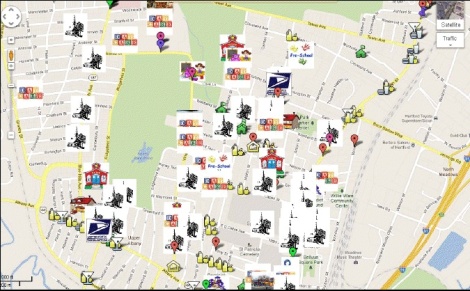
Some are more abstract representations of what might be out there:
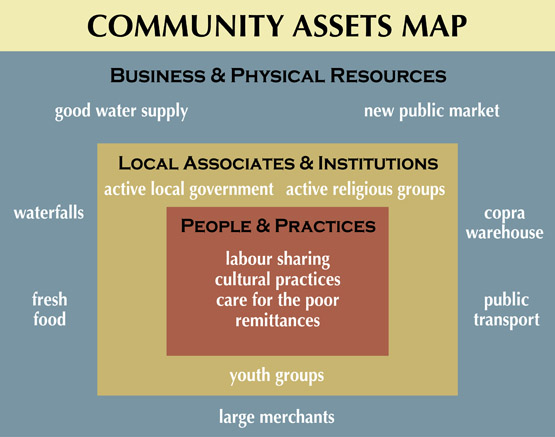
Some are built through play and building something that people can touch and feel:
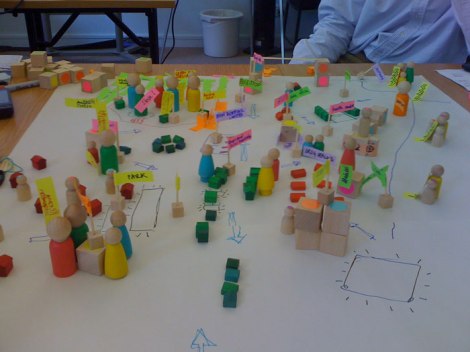
But they are all just rather crude and simplistic devices to help us move from unconscious to conscious; to help make the invisible visible; to help us open our eyes and ears and start paying attention to things that might be going on right under our noses.
Just as success for Lydia will mean that her ‘Driving Skills Book’ is long forgotten and buried at the bottom of her cupboard as she happily drives her mum to the station; so real success for ABCD will be when we’ve stopped needing our asset maps because we’ve got to know our communities and are making connections that allow us to be fully active citizens.
My favourite asset map by far is this one. I’m ashamed to say I can’t remember who produced it* but I do remember who shared it with me. I’ve not met Kathryn Anthon yet but we had a brilliant conversation about our respective organisations efforts to shift their practice to focus on strengths and what’s working in our communities. This map is not of services, institutions, projects, charities or systems. It’s a map of people and their own special gifts. When we are living in and experiencing our neighbourhoods like this then we really won’t need our maps any more.
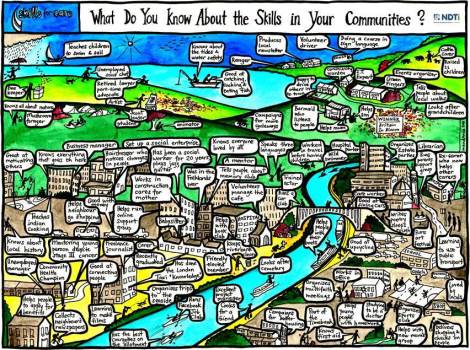
*March 2018 update. I’ve now been put in contact with the creator of this lovely picture and Pen Mendonca can be contacted here. It’s the simplest yet most powerful conveyance of the volume and diversity of skills that exist within any community which no doubt explains why it’s a drawing that gets shared again and again.
Great piece,, John. The community skills map was done by Pen Mendonca as a way of bringing a 90 page report on Skills for Care’s community skills programme to life. All the stories on the map relate to the projects the programme supported. We have blank version we ask people to fill with their own knowledge too.
LikeLike
Thanks Jim.
That’s a fascinating story in itself about the power of a picture to communicate 90 pages of words. I was in a meeting the other day where a massive report was being shared. “Just read the first 50 pages” was the advice….50 pages!
I do think Pen’s map is wonderful. Everyone I show it to just goes….Oh! now I see!
John
LikeLike
Brilliant piece John. Love the community skills map, its simple and really gets to the heart of the potential in our communities, how they can flourish and grow with the right ingredient and nurture. Looking forward to meeting you. Kathryn
LikeLiked by 1 person
Thanks Kathryn
Sorry I forget the source of the map. Really looking forward to meeting later in the summer. Wigan is where it’s at!!
John
LikeLike
Is it possible to get a copy of Pen’s map so that I can put it on a slide? Or just a section of it so that the writing is readable by an audience.
LikeLike
Hi Wendy. This is the best copy of the map that I’ve been able to source on line I’m afraid. But I reckon it’s very easy to produce one yourself….no need to copy Pen’s…just think about the community where you live and some of the people in that community. You don’t need any great drawing skills…I’m sure people will ‘get it’. Go on…give it a go. I’d love to see what you come up with.
LikeLike